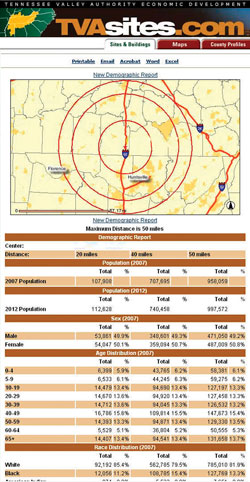

Do’s and Don’ts

eb-based research has become a critical part of the site selection process in recent years as corporate real estate executives, consultants and others looking for the best sites for their facilities conduct their due diligence. But like any category of Web sites, the quality of available information varies greatly.
Site Selection recently asked John Warden, executive vice president and co-founder of Atlanta-based site selection consultancy The Walker Companies, to share his thoughts on what makes a good economic development Web site and to pick some sites that stand out among the crowd. Warden says a good economic development Web site should feature critical site information and offer ease and flexibility in searches.
“A good Web site should be able to easily define the geography in which you want to do your search with landmarks, transportation infrastructure, major cities, ports and airports – all the kinds of things people want to be close to,” Walker says. “Ideally, it would have a map you can point to.”
Warden says a robust economic development Web site should also include floor plans of available buildings and show proximity to highways or railroads. Other critical information, such as location of utilities in relation to the site, should be available. Outlines of the site, with dimensions so it can be scaled and topographic information, are ideal as well, he says.
Other critical information that a site should have available are the square footage,
ceiling height and number of dock-height doors if a building is a manufacturing or distribution property.
“A floor plan or site plan is important, although very few Web sites tend to have that,” Warden says. “On some Web sites, you can’t search by ceiling height, and that’s a huge deficiency.”
Warden says the best economic development Web sites he has observed are operated by utility companies. He says the Tennessee Valley Authority and Georgia Power both offer capabilities that stand out above state Web sites. Both sites have good GIS capabilities and can pinpoint key criteria such as transportation infrastructure.
“TVA and Georgia Power have the best Web sites in terms of completeness of information, and the ability to extract it in areas that I want, rather than what some Web sites might think I want,” Warden says.
However, Warden is less impressed with most of the state economic development agency Web sites he has used.
“When you look at the state sites, I see a pretty significant reduction in functionality. The South Carolina site is pretty good. You can select sites through a map interface, but it is one county at a time and doesn’t include landmarks. There’s nothing on the map that would help me if I don’t know South Carolina geography.”
Warden says many state economic development Web sites have too much information that is not critical to a site search, and they don’t offer enough actionable information about sites and buildings.
“A lot of the data is meaningless for site selection,” he says. “They put it in there because they have it. The illusion is that quantity is quality. It sort of clogs up things.”
Warden says a common shortcoming among state Web sites is that they don’t offer enough actionable information about a particular site.
“All you can do is ID a building that meets the most simplistic of size requirements. You will have to make some phone calls to the owner or broker or the state to get more information. This concept is relatively new for some states, and they don’t have a good appreciation of what prospects are looking for.”
Warden believes that, over time, states will likely adopt GIS interface capabilities such as those used by TVA and Georgia Power.
“As GIS software becomes more adaptable to use over the Internet and less expensive, it could move in that direction,” he says.
Site Selection Online – The magazine of Corporate Real Estate Strategy and Area Economic Development.
©2008 Conway Data, Inc. All rights reserved. SiteNet data is from many sources and not warranted to be accurate or current.
